Professional Learning Communities: An Ongoing Exploration
Introduction

As researchers and practitioners examined school improvement efforts of the last decade or more, it became apparent that something important was missing. The narrow, piecemeal attempts made in the past to improve schools lacked the fundamental supportive cultures and conditions necessary for achieving significant gains in teaching and learning. Such attempts were insufficient. Too often, teachers worked in their own isolated classrooms, struggling with the needs of challenging students and lacking productive interaction with colleagues, through which they might have gained new insights and understandings about their practice. Many teachers remain ill prepared to teach every student successfully and lack the skills to challenge students by offering high-quality intellectual learning tasks. In addition, principals often do not know how to help teachers address their own critical learning needs.
We believe that professional learning communities offer an infrastructure to address these issues. The structure provides a context of collegiality, which supports teachers and administrators in improving their practice through learning new curriculum and instructional strategies and the methods for interacting meaningfully with each child. In other words, professional learning communities provide opportunities for professional staff to look deeply into the teaching and learning process and to learn how to become more effective in their work with students. Teacher learning comes first in such communities, Carmichael (1982) maintained, with the firm belief that students cannot raise their level of achievement until teachers become more effective in their own practice.
The term “professional learning community” defines itself. A school that operates as such engages the entire group of professionals in coming together for learning within a supportive, self-created community. Teacher and administrator learning is more complex, deeper, and more fruitful in a social setting, where the participants can interact, test their ideas, challenge their inferences and interpretations, and process new information with each other. When one learns alone, the individual learner (plus a book, article, or video) is the sole source of new information and ideas. When new ideas are processed in interaction with others, multiple sources of knowledge and expertise expand and test the new concepts as part of the learning experience. The professional learning community provides a setting that is richer and more stimulating.
In the publication Professional Learning Communities: Communities of Continuous Inquiry and Improvement, Hord (1997) noted that there was no universal definition of a professional learning community. Based on an extensive literature review of the subject, Hord conceptualized professional learning communities as schools in which the professional staff as a whole consistently operates along five dimensions: (1) supportive and shared leadership, (2) shared values and vision, (3) collective learning and application of learning (formerly identified as collective creativity), (4) supportive conditions, and (5) shared personal practice.
Establishing a professional learning community within a school does not occur quickly or spontaneously. It requires dedicated and intentional effort on the part of the administrator and the professional staff. Each dimension develops at its own pace, many times overlapping with other dimensions.
Next Page: A Review of the Five Dimensions

